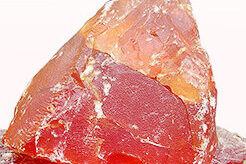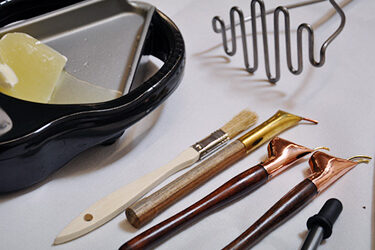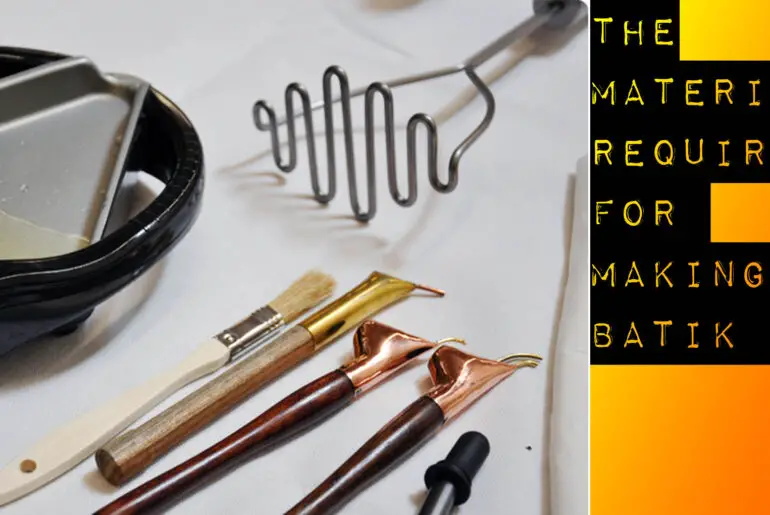There are several essential batik tools and materials for performing the batik process; some materials and tools vary depending on the batik technique used. In this article, we will talk about the basic materials and tools essential for making batik. The main steps in the batik process are as follows.
- TRACING
- WAXING
- DYEING
- DE-WAXING (BOILING)
- DRYING
- SEWING
- IRONING
What are THE MAIN MATERIALS AND TOOLS REQUIRED FOR BATIK
- Fabrics
- Wax
- Binder resin
- A metal bowl(metal pot)
- Tools
- Colors
The essential Batik tools and Batik materials are described separately below.
Batik tools and materials: Fabric
Fabric is an essential batik material. Fabrics made from natural fibres are often use for this purpose. The dye is easily absorbed into these fabrics. Cotton, Silk, Linen, and Wool are mainly used as fibres. In addition, other materials are used for this batiks. Cellulosic fibres are also widely used for this batik industry. This is because the selected fabrics are tight and smooth. These fabrics should be washed to remove impurities after purchase from the market. These may have been bleached and scoured, soak a little detergent powder in hot water and it will be easy to wash and iron well.We previously published a detailed article about fabrics, read it below
Read this For know the fabrics used for batiks and their qualities-Best Fabrics used For Batiks
Batik tools and materials: Wax
Several types of wax are used for batiks. Of these, Beeswax and Paraffin wax are the most commonly used.
- Paraffin Wax( petroleum wax)
What is paraffin wax: Paraffin wax is a soft, colorless substance obtained from petroleum, coal or shale oil. Remains solid at room temperature. Paraffin is hard and brittle; Dye penetrates anywhere where cracks occur. If a large number of cracks are required in a batik design, the paraffin content of the wax mixture should be increased
- Beeswax
What is Beeswax: Beeswax is a natural wax produced by the honey bees of the genus Apis. Beeswax is light yellow or tan and, it free of debris. Also these are flexible, soft, no cracks and completely blocks the spread of dyes.
The wax mixing ratios vary depending on the type of fabric selected. (Beeswax: Paraffin wax: Rosin)
recommend: 1-Pound Batik Wax
Batik tools and materials: Binder resin (Rosin)

Rosin is brittle at room temperature but it melts at high temperatures. Binder resin also a material used in making wax mixture. This melts when it melts and acts as a binder to the wax mixture. Remains solid under normal condition, when used, it turns into a powder.
Batik tools and materials: Metal pot
This is used to melt the wax. You can even use an electric frying pan for this. This process should be done very carefully, and the wax should be overheated as it may cause a fire.
Batik tools

Several tools are used to apply wax and dye. They are brushes, tjanting, tjaps, etc.further more different tools are used to perform other functions in the batik process. We previously published a detailed article about it, read it below
Read this For know the tools used for batiks and their process- List of Batik Tools and Explanation
How to use tjanting batik tool
Recommend Tools:
- Tjanting Tool (Set of 4)
- Hibiscus Handmade Indonesian Copper Tjap
- Fish Left Handmade Indonesian Copper Tjap
- Fish Right Handmade Indonesian Copper Tjap
Colors
Colors are an essential element of batiks art. People who are accustomed to these batiks designs distinguish the color combination needed for a particular design. Experience is essential for this. It is possible to color the invention with one or more of these colors. If a second color is applied, the first applied color should be covered with wax,
Azoic colors are commonly used. Azoic dyes are more popular as naphthol.
Batik dyes are used for coloring.
- Vat dyes
- Procion dyes
- Naphthol dyes
- Remasol dye( remazol dye)
- Etc.
FAQs: Batik tools and materials
What tools and materials are used for batik?
Batik, a traditional Indonesian wax-resist dyeing technique, typically requires tools and materials such as cotton fabric, wax (usually a mixture of beeswax and paraffin), a tjanting or canting (a tool for applying wax), dye, brushes, and a stretching frame. The process involves applying the wax to specific areas of the fabric to create patterns and then dyeing the fabric, with the wax preventing the dye from penetrating the waxed areas.
What materials are used in batik?
Batik traditionally uses natural materials, including cotton or silk fabric, natural beeswax mixed with paraffin wax for the wax-resist, and natural dyes derived from plants, barks, and other organic sources. However, modern variations of batik may also incorporate synthetic materials, such as synthetic dyes and synthetic fabrics, depending on the artist’s preferences and the desired outcome.
What is batik tools?
Batik tools typically include a tjanting or canting, a small instrument with a spout used to apply hot wax to fabric in precise patterns. Other essential tools involve brushes for wax application, a stretching frame to keep the fabric taut, and containers for heating and melting the wax. Additionally, artists may use various brushes and stamps to create intricate designs, making the toolset versatile and adaptable to different artistic styles.




